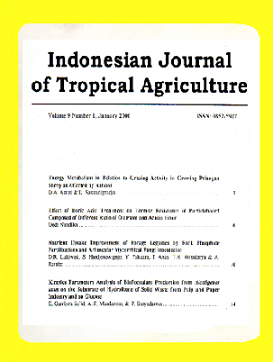ENERGY METABOLISM IN RELATION TO GRAZING ACTIVITY IN GROWING PRIANGAN SHEEP AS AFFECTED BY RATIONS
Abstract
Animal activities can cause variation in energy utilization. The effect of concentrate supplementation on grazing activity compare with housing condition was studied, in relation to energy metabolism. Sixteen growing Priangan Sheep (15 kg) werw allotted into four groups, two groups were fed with mix native grass plus 500 g.d-1 of concentrate (C+N) and ad libitum of mox native grass only (N), in the house using individual pens, whereas other two group were fed as same as mention above but they spent for a half of day in grazing area. Concentrate ration contained 17.40 MJ.kg-1 of gross energy (GE) and 18.00% of crude protein (CP), while the mix native brass contained 14.00 MJ.kg-1 GE and 12.60% of CP. Sheep were fed at approximately two times a day, morning and afternoon, while water were given ad libitum. Grazing time was started from 08:00 am. to 17.00 p.m., after and before fed by concentrate. Energy balance were measured during a 7-d experimental period, which was preceded by a month adaptation period. Average daily gain (ADC), heat production (HP), metabolizable energy (ME) and retained energy (RE) were measured using balance trial, heart rate (HR) was monitored using Polar Sport Tester and urea space for body composition. Results showed that dry matter intake (DMI) were 3.5% from the body weight (BW) in all groups. The values of ME on sheep fed by concentrate were 5.02 and 6.70 MJ.d-1 for housing and grazing groups, respectively, which were significance difference (P<0.05) with sheep fed native grass only, 4.73 and 4.86 MJ.d-1 for housing and grazing group, respectively. Heat production for grazing groups tended to be higher than for those housing (P=0.08), and the data showed that percentage of HP/GE start from 31 till 43%. Values of ADG and RE of sheep fed concentrate were higher than for those without concentrate, whereas the values were 109, 50, 114 and 48g.d-1 and 1.22, 0.56, 1.28 and 0.54 MJ.d-1 for housing and grazing, with and without concentrate, respectively. Percentage of fat and protein were around 20.99 and 19.31%. There was a good correlation between HP and HR following the equation Y=2.36 + 0.059 X witk r= 0.88, where Y=HP and X=HR. There were significance differences for percentage of body compositions among the groups.





